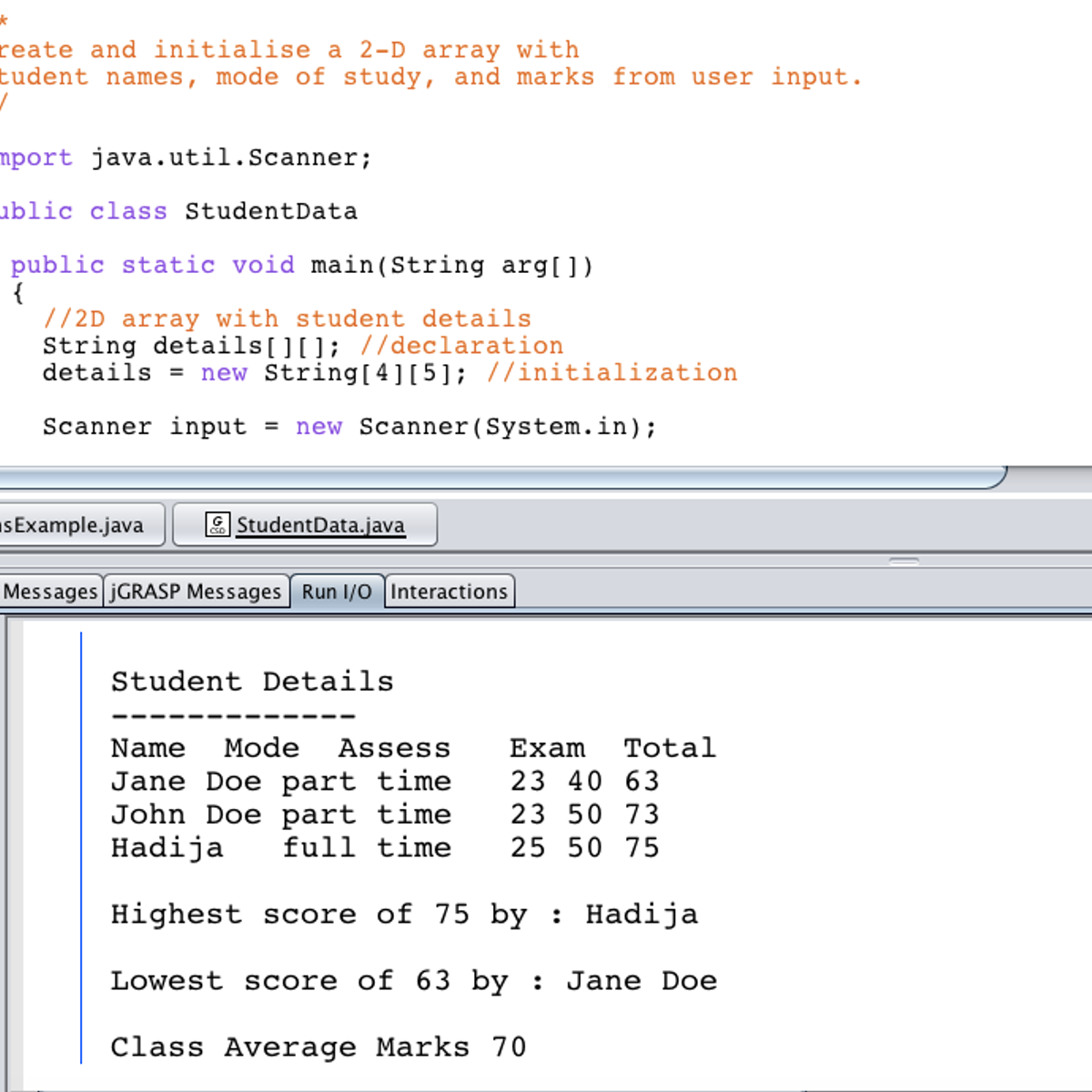
This project provides a step-by-step approach in instruction and will equip you with fundamental concepts of creating arrays and array lists in Java programming, from the ground up. Using jGRASP development environment, you will create a Java project that records and processes students’ data. The data includes name, mode of study, and marks. Using this data, you will output the student details, compute the total marks per student, determine the average mark, and the highest mark for the class. You will also be introduced to basic concepts in using array lists. By the end of this project, you will be able to write a Java program using one-dimensional arrays, two-dimensional arrays, one-dimensional array lists, and two-dimensional array lists.
Read more
This project provides a step-by-step approach in instruction and will equip you with fundamental concepts of creating arrays and array lists in Java programming, from the ground up. Using jGRASP development environment, you will create a Java project that records and processes students’ data. The data includes name, mode of study, and marks. Using this data, you will output the student details, compute the total marks per student, determine the average mark, and the highest mark for the class. You will also be introduced to basic concepts in using array lists. By the end of this project, you will be able to write a Java program using one-dimensional arrays, two-dimensional arrays, one-dimensional array lists, and two-dimensional array lists.
This project provides a step-by-step approach in instruction and will equip you with fundamental concepts of creating arrays and array lists in Java programming, from the ground up. Using jGRASP development environment, you will create a Java project that records and processes students’ data. The data includes name, mode of study, and marks. Using this data, you will output the student details, compute the total marks per student, determine the average mark, and the highest mark for the class. You will also be introduced to basic concepts in using array lists. By the end of this project, you will be able to write a Java program using one-dimensional arrays, two-dimensional arrays, one-dimensional array lists, and two-dimensional array lists.
If this is the first time you are learning about arrays and array lists you will benefit from writing a program from a blank sheet to a fully functioning program. If you already have programming experience, this is an opportunity to refresh your skills in array data structures. No matter your level, you will be able to apply the skills obtained from this course in real-life programming exercises. To provide you with support outside the course, you will find a pool of additional notes and exercises that you can try at home.
If you ever wanted to build on the fundamental skills in Java that you already possess and become better at using arrays, this project is the right place to start!
What's inside
Syllabus
Good to know
Save this course
Reviews summary
Well received: hands-on practice
Activities
Read 'Head First Java'
Show steps
Gain a comprehensive understanding of Java concepts and best practices through this insightful book.
View
Head First Java: A Brain-Friendly Guide
on Amazon
Show steps
-
Read through the book's chapters and engage with the interactive exercises
-
Apply the concepts to small coding projects
Review Java Basics
Show steps
Solidify your understanding of Java basics to ensure a strong foundation for this course.
Browse courses on
Java Basics
Show steps
-
Revisit Java syntax and data types
-
Practice writing simple Java programs
Implement a Student Data Management System
Show steps
Apply your understanding of arrays and array lists by creating a Java program that manages student data.
Show steps
-
Design the data structures to store student information
-
Implement methods to add, search, update, and delete student data
-
Create a user interface for interacting with the system
Show all three activities
Read 'Head First Java'
Show steps
Gain a comprehensive understanding of Java concepts and best practices through this insightful book.
View
Head First Java: A Brain-Friendly Guide
on Amazon
Show steps
- Read through the book's chapters and engage with the interactive exercises
- Apply the concepts to small coding projects
Review Java Basics
Show steps
Solidify your understanding of Java basics to ensure a strong foundation for this course.
Browse courses on
Java Basics
Show steps
- Revisit Java syntax and data types
- Practice writing simple Java programs
Implement a Student Data Management System
Show steps
Apply your understanding of arrays and array lists by creating a Java program that manages student data.
Show steps
- Design the data structures to store student information
- Implement methods to add, search, update, and delete student data
- Create a user interface for interacting with the system
Career center
Software Engineer
Data Analyst
Database Administrator
Web Developer
Computer Programmer
Systems Analyst
IT Support Specialist
Computer Science Teacher
Software Tester
Computer Network Administrator
Information Security Analyst
Business Analyst
Financial Analyst
Operations Research Analyst
Quantitative Analyst
Reading list
Share
Similar courses
OpenCourser helps millions of learners each year. People visit us to learn workspace skills, ace their exams, and nurture their curiosity.
Our extensive catalog contains over 50,000 courses and twice as many books. Browse by search, by topic, or even by career interests. We'll match you to the right resources quickly.
Find this site helpful? Tell a friend about us.
We're supported by our community of learners. When you purchase or subscribe to courses and programs or purchase books, we may earn a commission from our partners.
Your purchases help us maintain our catalog and keep our servers humming without ads.
Thank you for supporting OpenCourser.



